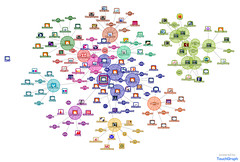 Last week, Mack Collier explained that he was switching his measurement for the Top 25 Marketing and Social Media blogs away from Technorati to Feedburner subscriber numbers. This has seen a big change in the blogs that make up the Top 25 — I am guessing this is mostly to do with the fact that many blogs don’t publish their subscriber numbers (or perhaps don’t even use Feedburner).
Last week, Mack Collier explained that he was switching his measurement for the Top 25 Marketing and Social Media blogs away from Technorati to Feedburner subscriber numbers. This has seen a big change in the blogs that make up the Top 25 — I am guessing this is mostly to do with the fact that many blogs don’t publish their subscriber numbers (or perhaps don’t even use Feedburner).
Now, I don’t actually publish my subscriber numbers — but it has not been a hard and fast decision. What do you think? Should I? What does it mean to you? Does a subscriber count influence your decision to read/subscribe? Does it influence the way you feel about a blog?
For the record, one of the reasons for not publishing is that I had setup three feeds very early on. I was able to consolidate down to two, and now have both running about neck and neck (about 600 each). And while I have tried to consolidate the feeds, I can’t quite get it to work. All new subscribers, please use this feed.
Mack’s list for week 120 is as follows. Congratulations to all on it!
1 – Duct Tape Marketing – 220,000 (LW – 6)
2 – Church of the Customer – 209,000 (LW – 8)
3 – CopyBlogger – 42,780 (LW – 2)
4 – Search Engine Guide – 12,173 (LW – 4)
5 – Chris Brogan – 8,319 (LW – 3)
6 – Influential Marketing – 6,985 (+12)(LW – 7)
7 – Logic + Emotion – 3,564 (LW – 5)
8 – Converstations – 3,219 (LW – 20)
9 – Drew’s Marketing Minute – 3,203 (LW – 15)
10 – The Viral Garden – 3,063 (LW – 25)
11 – Experience Curve – 2,775 (LW – UR)
12 – Conversation Agent – 2,713 (LW – 12)
13 – Techipedia – 2,300 (LW – 13)
14 – The Social Media Marketing Blog – 2,079 (LW – 19)
15 – Emergence Marketing – 1,829 (LW – UR)
16 – The Social Customer Manifesto – 1,672 (LW – UR)
17 – Techno Marketer – 1,367 (LW – 23)
18 – Social Media Explorer – 1,332 (LW – 18)
19 – Movie Marketing Madness – 1,231 (LW – UR)
20 – Daily Fix – 1,111 (LW – 10)
21 – Customers Rock! – 849 (LW – UR)
22 – Shotgun Marketing – 721 (LW – UR)
23 – Biz Solutions Plus – 541 (LW – UR)
24 – Resonance Partnership Blog – 301 (LW – UR)
25 – MediaPhyter – 116 (LW – UR)





